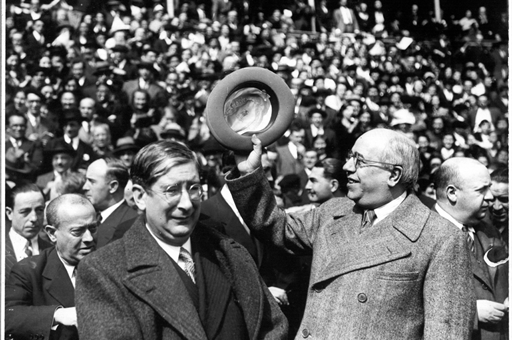Manuel Azaña is one of the most important figures in the contemporary history of Spain, both admired and vilified. He was one of the defenders of the Allied cause during the Great War. He played a prominent role at the Ateneo de Madrid, of which he was Secretary and President. He collaborated in different newspapers, directed the magazine España and founded La Pena. He received the National Prize for Literature in 1926 for a work on Juan Valera and was a notable translator of English and French.
Presentation

In its political dimension, Azaña is one of the main promoters of the arrival of the Republic in April 1931. The great debates of the period have their outstanding, and sometimes controversial, intervention: the Statute of Catalonia, the Agrarian Reform, the religious question or the vote of women. Not in vain, the Republic was identified with Azaña and Azaña with the Republic and blamed for the outcome of the Civil War, if not for its very beginning.
It is not strange, therefore, that periodically his figure comes back to light. On this occasion it does so on the occasion of the 80th anniversary of his death in exile and, for the first time in the recent history of Spain, the initiative to commemorate this anniversary has been officially carried out, as part of the recognition of whoever held the leadership of the State at the time.
The Ministry of the Presidency, Relations with the Courts and Democratic Memory, through the Secretary of State for Democratic Memory and with the collaboration of Acción Cultural Española, has organized a wide program of activities to pay tribute to the distinguished intellectual and political. The main focus of this program is the exhibition Azaña, intellectual and statesman, 80 years after his death in exile, which is held in the National Library.
The exhibition aims to provide a complete image of Manuel Azaña, in his triple dimension: human, intellectual and political, highlighting, in addition to his work as Minister, Head of the Government and President of the Republic, his status as an intellectual of prestige, as well as the harsh conditions of his exile, which ended with his death in the French city of Montauban, where his memory remains present eighty years later.
Following a chronological sequence that allows us to understand his trajectory in different periods: his childhood and youth in Alcalá, his subsequent development in Madrid, the exhibition goes into three crucial stages of the history of Spain: the Second Republic, the Civil War and Exile. The exhibition will show some two hundred works from both the BNE and other Spanish and foreign institutions. For this commemoration, photographs and videos have been rescued, very little known, which allow us to get closer not only to the figure and the work of Azaña, but also to the memory of his time.
This exhibition is the result of the work of a large team of experts from different fields who have worked with great dedication and rigour to make this tribute to Azaña take shape. In this regard, we must highlight the work done by the curators of the exhibition, Ángeles Egido and Jesús Cañete.
We would also like to express our gratitude to all the people, institutions, archives and documentation centres that have provided an invaluable and generous collaboration, as well as to all the authors who have collaborated in the Catalogue. We must also extend this gratitude to the institutions that have opened their doors and have been involved in the celebration of activities that take place within the framework of this commemoration. Without all of them, it would not have been possible to bring to fruition this collective enterprise whose main objective is none other than to highlight the legacy of Manuel Azaña, so necessary and valuable yet, in turbulent times.